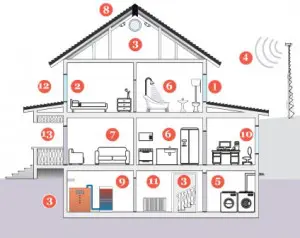The recent CBS 60-Minutes Report on Lumber Liquidators is just the latest example of how a healthier home can be a key ingredient in a Wellness Lifestyle.
The report left no doubt that contractors play a key role in creating healthier buildings. This leads to a key question: Should a building contractor’s job estimate come with a warning label?
After all, like the drugs prescribed by medical professionals, the work being done has the potential to adversely impact the health and wellbeing of every family member.
The contractor will be ripping open walls and ceilings, uncovering previously hidden potential dangers such as mold, dust, or even asbestos. They will ‘repair’ the damage according to specifications you outline, by introducing materials, adhesives, and coatings which can introduce chemicals which might outgas dangerous chemical indefinitely.
The reality is that few homeowners question what materials, or chemicals will be used to build or remodel their homes. So, the issue becomes, what responsibility does the contractor have to make their clients aware of the long-term implications of the work being one.
Increasingly contractors have begun to realize that homeowners cannot be expected to understand the building biology that will become their environment for a significant portion of each day. Building biology deals with the relationship between humans and their building environment. The concept originated over 20 years ago in Germany but has now spread worldwide as people realize that their health, and the health of their families, are tied to their home environment.
The impact might be an asthma attack in a youngster allergic to dust, or a reaction to mold spores that had lain dormant since the home was constructed years before. More serious implications such as sick building syndrome, or serious disease touched off by multiple chemical sensitivity are all possible, but are rarely covered by any construction contract.
Whether it’s the water we drink, the air we breathe or the unseen electromagnetic energy sources that inundate us daily, the impact can be substantial.
It’s doubtful that a contractor would want to cast him or herself into the role of lecturer, imposing a code of standards that home owners would have to fulfill to take advantage of the skills necessary for remodeling. But at the very least, they should offer resources to their clients and make sure they know that cleaner, healthier and safer alternatives exist.
Very often these alternative have financial implications and even more often, they are beyond the local building code requirements. But like doctors, who have an obligation to inform patients of all the alternative available, contractors need to make sure, consumers are making informed decisions.
Contractors don’t need to be experts, there is a whole new burgeoning industry of experts trained to help consumers, – but carpenters, plumbers, electricians and other professionals need to know where these resources can be found.
 If there were no health implications building materials should be designed so that they can return to the earth to be reused by future generations. The United States has long been criticized as a disposable society, ignoring the long-term social cost, of having the latest and greatest new invention. But slowly, the tide is turning and we are all becoming attuned to what will happen to our gadgets once we’ve tossed them aside.
If there were no health implications building materials should be designed so that they can return to the earth to be reused by future generations. The United States has long been criticized as a disposable society, ignoring the long-term social cost, of having the latest and greatest new invention. But slowly, the tide is turning and we are all becoming attuned to what will happen to our gadgets once we’ve tossed them aside.
The same should be true of buildings. Will the wood coated with preservatives ever decompose? Can materials be broken down by living organisms once it’s consigned to a landfill. If not, should we have been exposing humans to that chemical for 75 or 100 years when the house was inhabited.
Unfortunately for humans, the impact of out-gassing chemicals can be cumulative. Each one may be tested by a state or federal agency but, until recently, no one has measured the cumulative impact of the chemicals contractors use every day.
Now there are adhesives and bonding agents which produce few, if any, harmful gas as they cure. There are cost effective insulation and coatings that do not release chemicals into the home environment. There are finish materials such as no-VOC paints and sealants that don’t leave the finished project smelling like a chemical factory.
There are steps homeowners and contractors can take that go beyond ‘greening’ and energy efficiency that make the home less toxic in the long run.
Gone are the days when America consumers longed for that ‘new car smell’ when dad took everyone for a ride in the latest release from Detroit. Now we know that the smell was really the out-gassing of the many synthetic substances used to catch our attention on the dealer showroom.
No, contractor’s estimates don’t need a new warning label, but contractors and consumers need to know that they bear some responsibility for creating healthy living environments that will be safe as we live in them today and safer for future generations.
The next time you consider a kitchen or bathroom remodel, or your family outgrows your home and you decide that an addition is needed, ask your contractor about building biology and how it might impact your project.

 510-526-8524
510-526-8524
